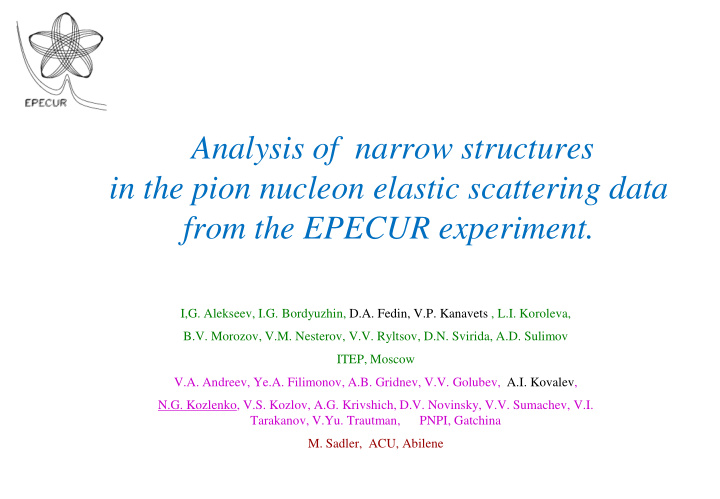



Analysis of narrow structures in the pion nucleon elastic scattering data from the EPECUR experiment. I,G. Alekseev, I.G. Bordyuzhin, D.A. Fedin, V.P. Kanavets , L.I. Koroleva, B.V. Morozov, V.M. Nesterov, V.V. Ryltsov, D.N. Svirida, A.D. Sulimov ITEP, Moscow V.A. Andreev, Ye.A. Filimonov, A.B. Gridnev, V.V. Golubev, A.I. Kovalev, N.G. Kozlenko, V.S. Kozlov, A.G. Krivshich, D.V. Novinsky, V.V. Sumachev, V.I. Tarakanov, V.Yu. Trautman, PNPI, Gatchina M. Sadler, ACU, Abilene
Pentaquark antidecuplet ЃЌЃЏђ ќ ђ Ѓ D.Diakonov et al. Z.Phys. A359, 1997, 305 Isospin = 0 Strangeness = +1 Mass ~1.530MeV Г ~ 15 MeV ? [10] Spin = 1/2 prediction – N***(Original 1710) From modified PWA – 1680 R. Arndt, Ya. Azimov, M. Polyakov, IS, R. Workman, Phys Rev C 69, 035208 (2004) HSQCD 2014 N.G. Kozlenko PNPI 2
Why pions? Theory gives weak coupling to πN sector. Advantages: 1. The structure of the πN amplitude is much more simpler than in photoproduction 2.The πN partials waves are known very well from phase shift analysis. 3.There is isospin symmetry. HSQCD 2014 N.G. Kozlenko PNPI 3
Pion beam Line (N322) at ITEP (Moscow) HSQCD 2014 N.G. Kozlenko PNPI 4
Setup for elastic scattering p p “EPECUR” Proportional chambers: DC1-4 (1FCH1-4) - the first focus and (2FCH1-4) - before the target. LqH2 - Hydrogen target DC[N] - drift chambers. S1, S2, A1 - Scintillation counters DC5-8 HSQCD 2014 N.G. Kozlenko PNPI 5
What is special in our experiment: • “Formation”– type experiment (s-channel). • Extremely high invariant mass resolution ( ~0.6 MeV ), provided by high momentum resolution of the magneto-optic channel 0.1%. • Magnetless spectrometer with drift chambers. • Liquid hydrogen target. • Very small amount of matter on the particle paths. • High statistical precision: better 1% . HSQCD 2014 N.G. Kozlenko PNPI 6
ˉ p ˉ p Forum for MAX-IV Ring, Lund, Nov 2011 HSQCD 2014 N.G. Kozlenko PNPI 7
ˉ p ˉ p - partial wave analysis from GWU (WI08) - EPECUR results HSQCD 2014 N.G. Kozlenko PNPI 8
ˉ p ˉ p - partial wave analysis from GWU (WI08) - EPECUR results HSQCD 2014 N.G. Kozlenko PNPI 9
+ p + p - partial wave amplitudes from GWU analysis HSQCD 2014 N.G. Kozlenko PNPI 10
+ p + p - partial wave amplitudes from GWU analysis HSQCD 2014 N.G. Kozlenko PNPI 11
Now we will try to describe the observed structures using the two resonances, and for that we will use: K-matrix approach with effective Lagrangians. P.F.A. Goudsmit et al Nucl.Phys A575 (1994)673 A.B. Gridnev, N.G. Kozlenko. Eur.Phys.J.A4:187-194, (1999). T. Feuster and U. Mosel Phys. Rec. C 58 457 (1998). It is assumed that the K-matrix, being a solution of the equation for scattering amplitude, can be considered as a sum of the tree- level Feynman diagrams with the effective Lagrangians in the vertices. HSQCD 2014 N.G. Kozlenko PNPI 12
We included: 4* resonances from PDG in s and u channels and σ , ρ like exchange in t channel. Multichannel: 1. elastic scattering 2. two pion production(effective) 3. η n production 4. K Λ production 5. K Σ production HSQCD 2014 N.G. Kozlenko PNPI 13
Free parameters → coupling constants and masses. We concentrate on elastic scattering and treat inelastic channels approximately to save the number of free parameters. Database: • EPECURE results • PWA GWU single energy solutions up to 1GeV/c • η n total cross section • K Λ differential cross section • K 0 Σ 0 differential cross section • K + Σ + differential cross section • K + Σ - differential cross section HSQCD 2014 N.G. Kozlenko PNPI 14
ˉ p ˉ p - partial wave amplitudes from GWU analysis - K-matrix analysis - EPECUR results HSQCD 2014 N.G. Kozlenko PNPI 15
ˉ p ˉ p HSQCD 2014 N.G. Kozlenko PNPI 16
+ p + p HSQCD 2014 N.G. Kozlenko PNPI 17
+ p + p HSQCD 2014 N.G. Kozlenko PNPI 18
- Single Energy partial wave amplitude from GWU analysis - K-matrix analysis HSQCD 2014 N.G. Kozlenko PNPI 19
ˉ p η n HSQCD 2014 N.G. Kozlenko PNPI 20
ˉ p Kº Λ HSQCD 2014 N.G. Kozlenko PNPI 21
ˉ p Kº Λ HSQCD 2014 N.G. Kozlenko PNPI 22
ˉ p Kº Σº HSQCD 2014 N.G. Kozlenko PNPI 23
+ ˉ p K Σˉ HSQCD 2014 N.G. Kozlenko PNPI 24
Very preliminary S11 P11 M=1686(1.5) M=1710(2.0) Γ tot =18.2 MeV Γ tot =25.0 MeV Γ el =0.1 MeV Γ el =0.25 MeV Γ 2π =10.0 MeV Γ 2π =10.0 MeV Γ ήn =8.0 MeV Γ ήn =5.1 MeV Γ KΛ =0.1 MeV Γ KΛ =0.25 MeV Γ KΣ =9.0 MeV HSQCD 2014 N.G. Kozlenko PNPI 25
M=1686 S11 →P11→ χ 2 ↑ 15% M=1710 P11 →S11→ χ 2 ↑ 25 % Another explanations (for η photoproduction) 1.Interference effects. Interference of well-known resonances Interference of S11(1650) and P11(1710) . V. Shklyar, H. Lenske , U. Mosel , PLB650 (2007) 172 (Giessen group ) Interference of S11(1535) and S11(1650) . A. Anisovich et al. EPJA 41, 13 (2009) (Bonn-Gatchina group); We not found such solution 2.Cusp effect M.Doring, K. Nakayama, PLB B683:145 (2010) We are working on this possibility HSQCD 2014 N.G. Kozlenko PNPI 26
Conclusions • The observed structures in the differential cross section of the π ¯p elastic scattering can be described by two narrow resonances S11(1686) and P11(1710). • Further investigation on the nature of this structures requires more precise data for inelastic channels of π ¯p reaction. HSQCD 2014 N.G. Kozlenko PNPI 27
Thank you for your attention! HSQCD 2014 N.G. Kozlenko PNPI 28
Recommend
More recommend